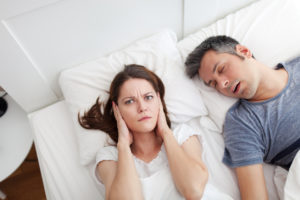 According to the National Sleep Foundation, more than 18 million Americans suffer from sleep apnea. Those are staggering numbers. At Ponte Vedra Complete Dentistry, our blog serves as an educational tool for all things dentistry. Today we felt compelled to discuss snoring and sleep apnea. If you suffer from either of these problems or if a loved one suffers, we encourage you to read on. Dentistry has brought about some terrific advances in sleep apnea treatment. We hope you enjoy!
According to the National Sleep Foundation, more than 18 million Americans suffer from sleep apnea. Those are staggering numbers. At Ponte Vedra Complete Dentistry, our blog serves as an educational tool for all things dentistry. Today we felt compelled to discuss snoring and sleep apnea. If you suffer from either of these problems or if a loved one suffers, we encourage you to read on. Dentistry has brought about some terrific advances in sleep apnea treatment. We hope you enjoy!
Is Snoring Dangerous?
Although we are certain that many wives and husbands will tell you that snoring is bad, it does not inherently have any negative medical implications. Snoring, however, may be a sign of a more dangerous problem. Many people that snore also have sleep apnea. We will explain why.
What is Sleep Apnea?
Apnea means the absence of breath. There are two major variations of sleep apnea; central and obstructive. Central sleep apnea is much less common and occurs from a lack of adequate neural signal. Due to the complexity and rarity, we will not discuss this variation. Obstructive sleep apnea is much more common. Obstructive sleep apnea occurs due to a blockage of proper airway flow during sleep. The diaphragm and muscles of the chest continue to work to pull air into the lungs. A gasp or jerk of the body often accompanies the next breath.
Obstructive sleep apnea can be classified by the number of episodes (apnea and hypopnea) per hour. Mild sleep apnea is between 5-14 episodes, moderate is between 15-29, and severe is greater than 30 per hour.
Why is Sleep Apnea Dangerous?
Potentially the most dangerous implication of sleep apnea relates to the heart. To simplify, the lungs are not able to bring in adequate amounts of oxygen. As a result the heart is forced to work overtime. This can have potentially fatal long term results. The American Lung Association reports that obstructive sleep apnea can increase the risk of high blood pressure, heart attack, stroke, heart failure, and work related or driving accidents.
Who Gets Sleep Apnea?
Although anyone (even children) can have obstructive sleep apnea, there are certain demographics that are more commonly affected. Risk factors include;
- Being overweight
- Alcohol intake – especially before bed
- Smoking
- Hypertension
- Age – older people are more at risk
- Gender – males are more at risk
- Family history
How is Sleep Apnea Diagnosed?
The true diagnosis of obstructive sleep apnea is a complete sleep test. A sleep medicine physician is the best resource. At Ponte Vedra Complete Dentistry, we provide a take-home sleep study if sleep apnea is suspected. The results of this sleep study tell us if obstructive sleep apnea is probable. In the event that the results suggest obstructive sleep apnea, a referral to a sleep medicine physician can be made.
How is Sleep Apnea Treated?
The gold standard for treatment of obstructive sleep apnea is the CPAP. The CPAP essentially forces air into the airway to maintain a steady flow of intake. There are drawbacks to the CPAP. Most patients have reported this device as uncomfortable, often so much as to force them to discontinue use. If not used, no benefit can be obtained.
In recent years, dentists have become extremely important in the field of sleep apnea. The American Sleep Apnea Association states that the dental treatment for sleep apnea has become the first line of treatment for many who suffer from obstructive sleep apnea. This has led them to approve the dental device as the first line of treatment for mild to moderate sleep apnea.
The appliance is a comfortable mouthpiece that moves the lower jaw forward during use. This essentially elongates all of the muscles and soft tissues that are relaxing and cutting off the airway during sleep. Due to the comfort of this appliance, the compliance rates of this device far exceed the CPAP.



